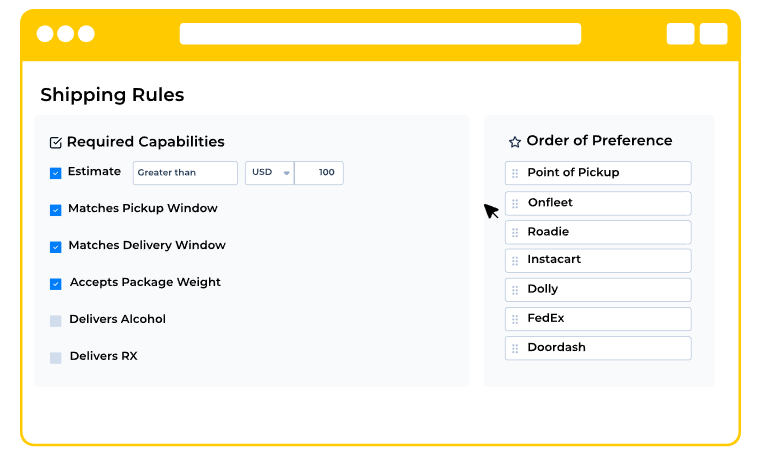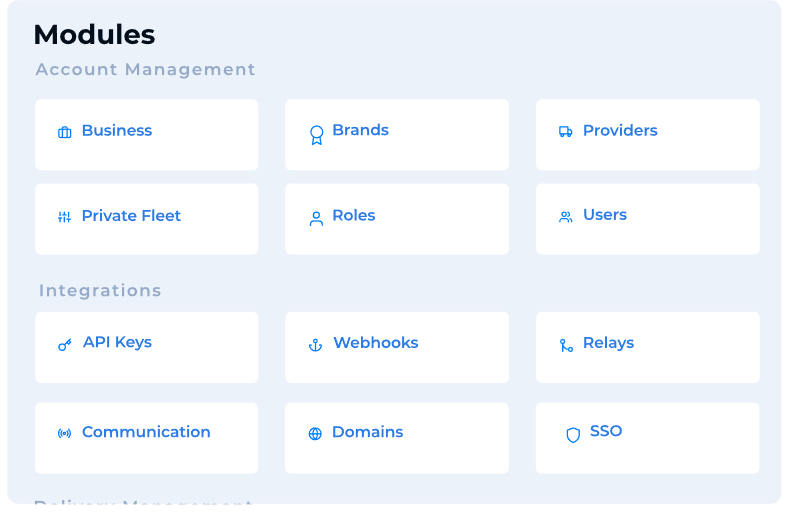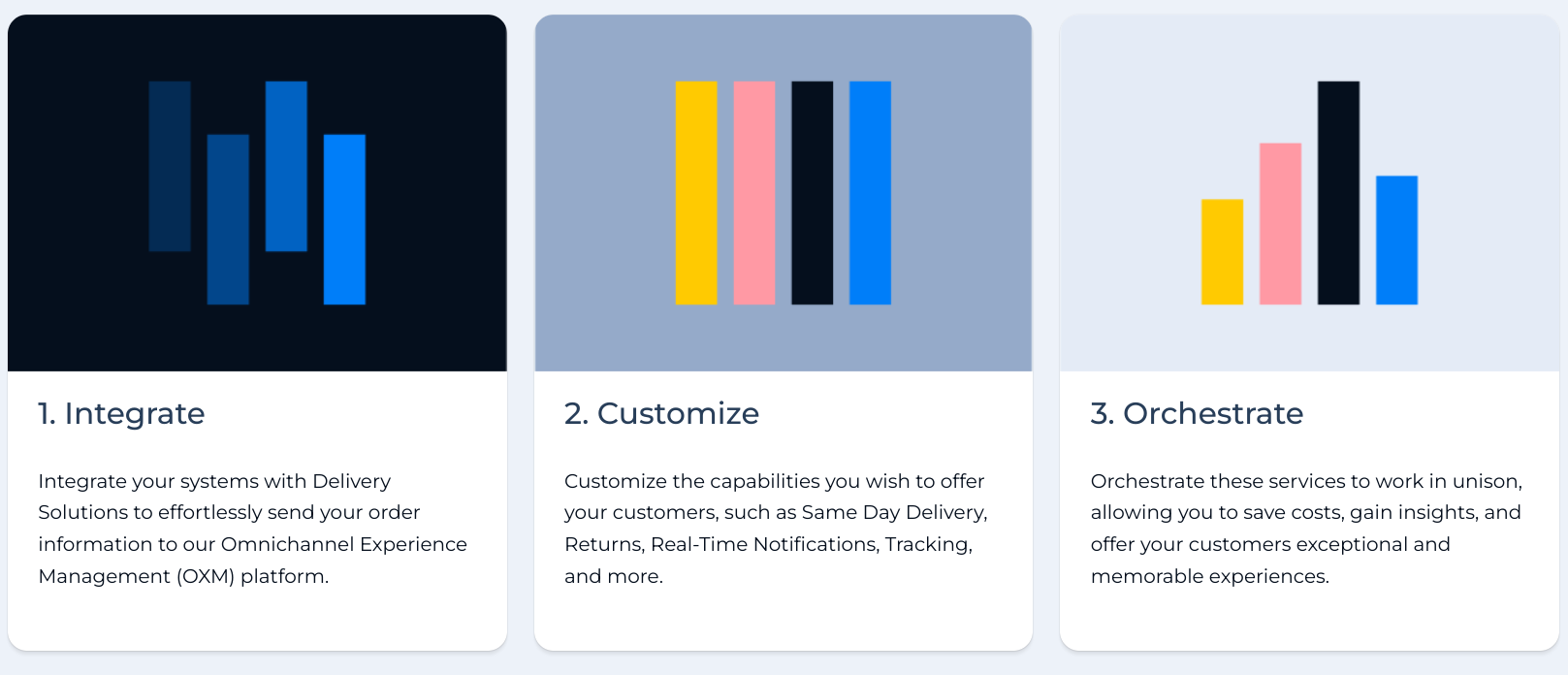Omnichannel orchestration of logistics is much like conducting an orchestra. Many individuals play different instruments, divided into sections by instrument and sound. Each group plays their respective parts printed on the same music sheet for the same song.
And a single conductor orchestrating them all.
Omnichannel orchestration involves many different departments, teams, and individuals. Each has different responsibilities and different projects. But all are working toward the same end goal.
Keeping all those moving parts organized, managed, working together, and flowing seamlessly toward the same end is incredibly challenging.
Middle-mile logistics, last-mile logistics, reverse logistics, fleet management, operations management, retail management, CRM, marketing…
How can one “conductor” orchestrate so many phases simultaneously?
With automation.
Let’s look at how automation in omnichannel orchestration changes the game and how Delivery Solutions is leading the pack with its omnichannel experience platform.
What is omnichannel orchestration?
Omnichannel orchestration refers to the seamless integration and coordination of multiple systems to fulfill customer orders efficiently and effectively. It ensures cohesive customer interactions and shopping experiences across all preferred touchpoints.
The concept of omnichannel orchestration has evolved. There's a growing prevalence of e-commerce and demand for unified shopping experiences.
Historically, retailers operated through siloed channels. This led to disjointed customer experiences and inefficiencies in order management and fulfillment.
Arshaad Mirza and Manil Uppal, the founders of Delivery Solutions, recognized the need for a more integrated approach, specifically regarding last-mile delivery. They pioneered last-mile orchestration, a key component of omnichannel logistics.
Their innovative platform enables retailers to streamline last-mile operations, improve fulfillment speed and accuracy, and enhance customer satisfaction.
Mirza and Uppal revolutionized how retailers approach order fulfillment. Delivery Solutions’ platform sets new standards for efficiency and seamless customer experiences in the omnichannel era.
The benefits of automation in omnichannel orchestration
There are a host of benefits to incorporating automation in omnichannel orchestration for your business.
Reduces delays
Automation in omnichannel orchestration streamlines processes, which reduces delays and optimizes operations.
Automating tasks like order processing and routing accelerates order fulfillment, ensuring swift delivery. It identifies real-time bottlenecks, pinpointing areas where processes slow down or halt. This allows for immediate intervention.
Additionally, automation enables self-troubleshooting mechanisms, where systems can detect and resolve issues autonomously. This minimizes downtime and disruptions.
This proactive approach accelerates operations and enhances overall reliability and customer satisfaction.
Delivery Solutions contains automation features such as Exceptions and Artificial Intelligence & Machine Learning (AI/ML). These features help reduce fulfillment delays with Agile Rerouting, Autonomous Issue Resolution, and Smart Delivery Assurance.
Improves visibility
Brands have started to invest more in supply chain visibility and have reaped the benefits. However, many admit they still have far to go, especially concerning moving beyond surface-level visibility into the deeper levels of the supply chain.
Automation in omnichannel orchestration significantly enhances visibility throughout the supply chain. This comprehensive visibility into operations facilitates better decision-making and enhances customer satisfaction.
Real-time order tracking enables order tracking through various stages, providing transparency to customers. Delivery Solutions’ Post-Purchase features include end-to-end tracking capabilities to keep customers updated on their delivery status. Sixty-six percent of shoppers value this transparency.
Fleet tracking features allow real-time monitoring of delivery vehicles. This monitoring helps with optimizing routes and schedules for efficient delivery.
Automation streamlines inventory management by providing accurate, real-time stock levels across multiple channels and locations. This visibility enables businesses to make informed decisions, anticipate demand, and prevent stockouts or overstocking.
Harmonizes and streamlines channel-specific processes
Integrating systems and workflows creates a cohesive, unified framework of channel-specific processes. Automating tasks like order processing, inventory management, and customer communication seamlessly implements this integration.
It guarantees consistent experiences across online, in-store, and mobile shopping. It also reduces manual errors and inconsistencies. For example, automation can synchronize inventory levels in real time to ensure that online and in-store items are in stock.
Automation also enables personalized customer experiences by leveraging customer behavior data and preferences across channels for targeted promotions and recommendations.
Delivery Solutions Orchestration feature harmonizes all your existing systems, streamlining your processes and creating a consistent customer experience.
Simplifies choice of shipping and delivery carriers
Automation simplifies carrier selection by leveraging real-time data and algorithms to make informed decisions.
Automation can analyze factors such as shipping rates, delivery times, and service levels to determine the optimal carrier for each order through integrations with various carrier services and shipping platforms.
Choose the best carrier for every shipment based on package size, destination, and customer preferences.
Automation helps save time by eliminating the need for manual comparison shopping. It also reduces the risk of errors or delays in choosing the wrong carrier.
Additionally, it can dynamically adjust carrier selections based on real-time factors like weather conditions or transit disruptions, further optimizing the shipping process.
This choice simplification is displayed when a business leverages Delivery Solutions’ Shipping and Single Contract features in its last-mile processes.
Decreases operational costs
Automating repetitive tasks such as order processing, inventory management, and customer communication helps reduce the need for manual labor. This results in lower labor costs and increased efficiency.
Automation also optimizes resource use by streamlining workflows and eliminating inefficiencies.
Take inventory management, for example. Over 50% of consumers abandon their carts due to an item being out of stock, and roughly 90% will search for the same product elsewhere.
Automation helps prevent overstocking or stockouts, minimizing carrying costs and lost sales opportunities.
Moreover, automation enables better decision-making through real-time insights and data analysis. This reduces the risk of costly errors and allows businesses to allocate resources more effectively.
Additionally, automation improves customer satisfaction by enhancing the overall shopping experience. Improved customer experience leads to higher retention rates and lower customer acquisition costs.
Reduces manual involvement
Automating repetitive tasks minimizes the risk of human error. By streamlining processes, automation guarantees consistency and accuracy across operations.
Automation is also time-efficient, as it performs tasks much faster than manual. This translates to quicker order fulfillment and improved customer satisfaction. This efficiency also allows businesses to meet the demands of today's fast-paced market and stay competitive.
Moreover, automation enables businesses to reallocate their workforce to other projects and tasks. They can assign employees assignments requiring human creativity, critical thinking, and problem-solving skills.
By freeing staff from mundane, repetitive tasks, businesses can apply talent to more value-added activities, driving innovation and growth.
Integrates different software
Omnichannel orchestration automation integrates different software through robust solutions.
The platform is a bridge facilitating information flow between systems by translating data formats and protocols. It also enables seamless communication and data sharing between diverse platforms.
Integrating e-commerce platforms with inventory management systems synchronizes product availability across channels. Connecting CRMs to order processing systems ensures consistent customer data and order tracking.
Enhances customer satisfaction
You can offer various fulfillment options through automation, including same-day delivery, curbside pickup, BOPA, and shipping. This flexibility enables choices for the most convenient delivery method, increasing customer loyalty and satisfaction.
Automation also enables personalized experiences, which boost engagement and satisfaction. Thirty-one percent of consumers are drawn to these targeted marketing strategies, and 37% are most influenced by ads directly linked to their favorite brand or product offers.
Systems can leverage customer data to tailor product recommendations, promotions, and communication channels. You can deliver relevant offers and messages by understanding each customer's preferences and purchase history.
Additionally, automation integrates online and in-person experiences by synchronizing inventory levels, pricing, and promotions across channels.
The transition between online browsing and in-store shopping becomes an enjoyable, cohesive, and seamless experience.
Fosters sustainability
An increasing number of consumers expect the brands they engage with to care about their environmental footprint. Automation optimizes resource utilization, reduces waste, and minimizes environmental impact throughout the supply chain.
Automating inventory management processes helps minimize overstocking. Automated order fulfillment and returns facilitate more sustainable options that reduce the need for excess packaging materials. These changes allow you to decrease waste and conserve resources.
Furthermore, automation enables more efficient transportation and logistics operations. Route optimization and dynamic scheduling reduce fuel consumption and greenhouse gas emissions.
Automated systems can also monitor energy usage in warehouses and distribution centers. They can identify opportunities for energy savings and help implement sustainable practices.
Additionally, automation facilitates data-driven decision-making. It enables you to analyze environmental metrics to gain a deep understanding of impact to identify improvement areas.
By leveraging automation to track and report on key sustainability indicators, you can transparently communicate environmental efforts to stakeholders and consumers. This fosters trust and loyalty among the populations that care most about this issue.

Boosts efficiencies in processes
Omnichannel orchestration automation with a platform like Delivery Solutions optimizes processes across the supply chain. This boosts efficiencies in various areas.
Automated route planning systems select the most efficient delivery routes, reducing fuel costs, transit times, and deadhead miles. Automated workflows streamline operations, minimizing errors and delays.
Automation in order processing and inventory management systems accelerates order fulfillment. Faster, more efficient order fulfillment ensures timely delivery to customers. Fast delivery is a top priority for 60% of consumers — fast as in 24 hours or less for most.
Returns processes are expedited with automated return authorization and processing, enhancing customer satisfaction.
Warehouse management automation helps track, pick, and replenish inventory. This automation improves accuracy and reduces labor costs. The market share for global warehouse automation was valued at $23 million last year and is expected to continue rising.
Supports organizational growth
Automation offers scalability and seamless integration with new technology and innovations.
Automation allows you to efficiently scale operations to meet growing demands without proportionally increasing labor costs. As transaction volumes increase, automated systems can handle higher workloads. This will ensure consistent service levels and customer satisfaction.
Moreover, automation is adaptable and can easily integrate with new technologies and innovations. Automated systems can seamlessly incorporate emerging technologies into existing workflows, including:
- AI-driven chatbots for customer service
- Predictive analytics for demand forecasting
- IoT devices for real-time inventory tracking
- AI-powered robots for warehouse operations
This flexibility lets you stay ahead of the curve, drive innovation, and capitalize on new growth opportunities.

The challenges of automation in omnichannel orchestration
Automation in omnichannel orchestration presents several challenges to navigate.
Implementation
Implementation can be complex, expensive, and time-consuming. It can require integration with existing systems, customization to meet specific business needs, and coordination across departments. It may involve complex system migrations and process redesigns.
All this can lead to potential disruptions in operations and resistance from stakeholders. Ensuring seamless integration and minimal disruption to operations during implementation is crucial.
Selecting our platform ensures a smooth, non-disruptive implementation and integration.
Booking a live demo for the solution you’re considering, feeling out the customer support team, and inquiring about the deployment process will also help minimize the headaches involved with implementation.
Security and privacy
Data privacy and security concerns arise due to the increased reliance on data and technology in automated systems. There’s especially a concern when handling sensitive customer information across multiple digital channels.
Eighty-four percent of consumers consider data privacy a human right. So, it’s important to protect this data from breaches and unauthorized access. Ensure you comply with regulations like GDPR to maintain trust and credibility.
Robust security measures, such as encryption, access controls, and regular audits, are essential to mitigating risks.
Training
Automation may require employees to adapt to new tools, processes, and workflows. Institute comprehensive training programs and provide support resources. This will equip employees with the skills to effectively operate and manage automated systems.
Fostering a continuous learning and skill development culture can help them embrace automation to enhance their productivity and effectiveness.
You may also experience resistance to change and fear of job displacement from employees. This could call for a change in management strategies to foster acceptance and collaboration.
Take the next step in adopting automation in omnichannel orchestration
We’re living in a time where automation in omnichannel orchestration is a must-have. Without it, you’ll be hard-pressed to achieve operational efficiency, customer satisfaction, and seamless, integrated processes.
Delivery Solutions' omnichannel experience products for everything after the sale help enterprise retailers scale with flexible options that boost savings and brand loyalty.
To see firsthand how Delivery Solutions helps to conduct the “symphony orchestra” that is your supply chain, book a live demo today.
Ryan Caldarone
Ryan is a Sr. Digital Marketing Manager with over ten years of experience in B2B eCommerce, specializing in brand storytelling and content. Having contributed to hundreds of creative projects for SMBs and startups across the tech, energy, and fine arts sectors, Ryan brings diverse perspectives.
Topics from this blog: Logistics
.png)
 (
( (
( (
( (
(